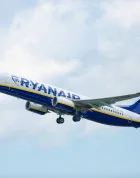New carriers expanding to Canada always makes for an exciting development in our Miles & Points landscape.
As Canadian travellers, we’re often forced to transit the US in order to access a wider range of airlines when flying internationally. COVID-19 has only made this a more precarious, given the constantly changing travel rules and regulations.
Therefore, it’s now more valuable than ever to have direct flight options from Canada, and we’ve recently gotten some good news in that regard.
Colombia-based Star Alliance member Avianca has launched a new route from Toronto to Bogotá, offering thrice-weekly flights as of December 3, 2021.
Avianca’s New Toronto–Bogotá Route
The flight in both directions is flown on Tuesdays, Fridays, and Saturdays, and the flight times are as follows:
-
AV205 Toronto (YYZ) to Bogotá (BOG), departing 10:50pm and arriving 5:00am the next day
-
AV204 Bogotá (BOG) to Toronto (YYZ), departing 3:20pm and arriving 9:30pm

The flight will be operated by an Airbus A319 aircraft, and represents Avianca’s first Canadian destination served out of Bogotá.
It’s worth noting that the Latin American airline giant already serves Toronto with an existing five-times-weekly flight to San Salvador, their Central American secondary hub.
Avianca’s Toronto–Bogotá service will compete with Air Canada’s existing four-times-weekly flights on the same route. However, the key advantage that Avianca offers is that their flight rewards wouldn’t be subject to Aeroplan’s dynamic pricing, as we’ll discuss below.
Booking Avianca’s New Toronto–Bogotá Flights
Since Avianca is one of Aeroplan’s 44 partners, it’s easy to redeem Aeroplan points for this flight directly, whether you’re only flying to Colombia or using it as a jumping-off point for the rest of South America.
The direct flight is 2,704 miles and costs 50,000 Aeroplan points per person one-way in business class.
Looking at Aeroplan’s Flight Reward Chart for travel between North and South America, we can see that this falls significantly under the mileage limit of 4,500 miles for the first distance band, meaning you can fly approximately 1,796 more miles for the same price.
Since we’re always looking to redeem our points for maximum value, we can take a quick look through Avianca’s route network to assess our options for further exploring the continent by leveraging the new Toronto–Bogotá direct flight.
For the same 50,000 Aeroplan points, you’d be able to continue onwards to other destinations in Colombia; Quito, Ecuador; Lima, Peru; or La Paz or Santa Cruz in Bolivia – all while staying under 4,500 miles in distance flown.
You’d also be able to add a stopover in the Colombian capital of up to 45 days in duration for an extra 5,000 Aeroplan points (i.e., a total of 55,000 Aeroplan points).
Meanwhile, any of Avianca’s further destinations in South America will cost a marginal 10,000 points more, for a total of 60,000 Aeroplan points (or 65,000 points if you add a stopover in Bogotá).
How Is Avianca Business Class?
While Avianca does offer a competitive reverse herringbone business class product on their Boeing 787 Dreamliners, unfortunately that won’t be the plane flown on this new route to Toronto.
Heck, Avianca won’t even be using their Airbus A330s with angled-flat seats – but rather, the route debuts with narrow-body Airbus A319 planes, featuring a “regional” business class product with recliner seats.

As a point of comparison, Air Canada operates the Airbus A330 on their routes to Bogotá from Toronto and Montreal, which are fully refurbished with Signature Class seats with lie-flat pods.
If both Air Canada and Avianca flights are available at similar prices, I’d pick Air Canada’s A330 all day long. However, since Air Canada flights are subject to Aeroplan’s dynamic pricing, Avianca might just be your best bet if you’re looking for a reasonably priced partner award down to South America.
As I’ve touched upon before, flying to Central & South America doesn’t always come with the glitz and glamour of sampling the world’s best business class products, as there are relatively few lie-flat options in these lower-revenue, leisure-oriented markets.
In light of that reality, convenience often takes priority over comfort when planning travel down to Latin America, and Avianca’s new Toronto–Bogotá route certainly adds a welcome new option in this regard.
Conclusion
Avianca has launched thrice-weekly flights between Toronto and Bogotá on Tuesdays, Fridays, and Saturdays.
For business class redemptions, the new route is priced at 50,000 Aeroplan points for trips up to 4,500 miles in distance flown, and 60,000 Aeroplan points for trips to South America beyond that threshold.
Avianca will be operating this route using Airbus A319s, which offers a meagre regional business class seat. It’s very much an inferior business class product compared to Air Canada’s A330 Signature Class; however, Avianca’s fixed partner pricing could very well make it the more attractive option to book.
Either way, it’s always useful when airlines add routes that open up more options to book with points, and let’s hope that Avianca serves Toronto with a stronger business class product should travel demand increase in the future.




















I booked flights to Quito via Bogota directly with Avianca as the Air Canada options for the dates I wanted were not good. I went for business class even though I would have preferred the lie-flat seats on the Air Canada codeshare. Any idea what lounge (if any) Avianca uses in Terminal 1 YYZ?
These flights have been around for many years and I have taken them. The only thing is the schedule for the outbound flight is horrible.
Given the extremely cheap cash fares for this route, I assume it’d hardly make sense for one to shell out so many points. In what situation could redeeming points be a better option?
Fares on the direct route are indeed quite affordable, even in business class. Connecting anywhere further in South America, though, and you’re looking at ~3cpp returns – more if you add a stopover. Certainly not as good as what you’d get going to Europe or Asia, but then again, travel to South America rarely goes hand in hand with maximizing CPPs.